
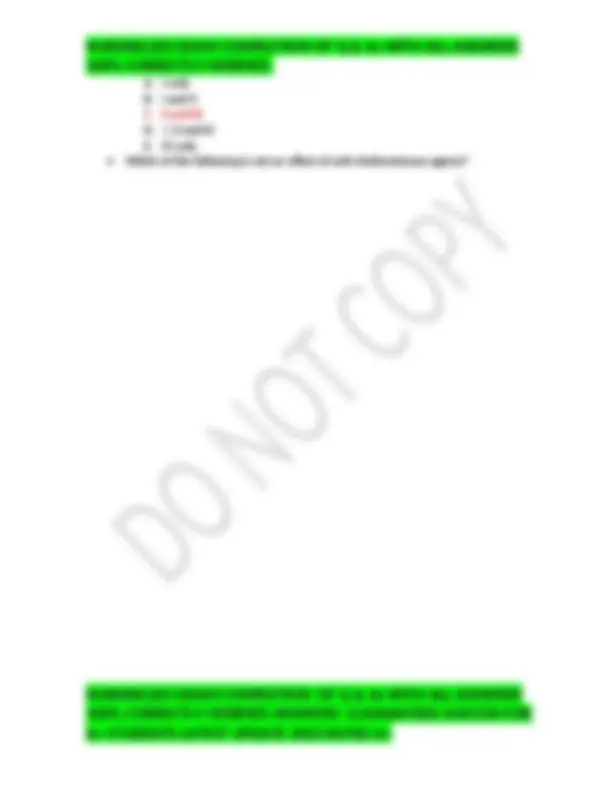
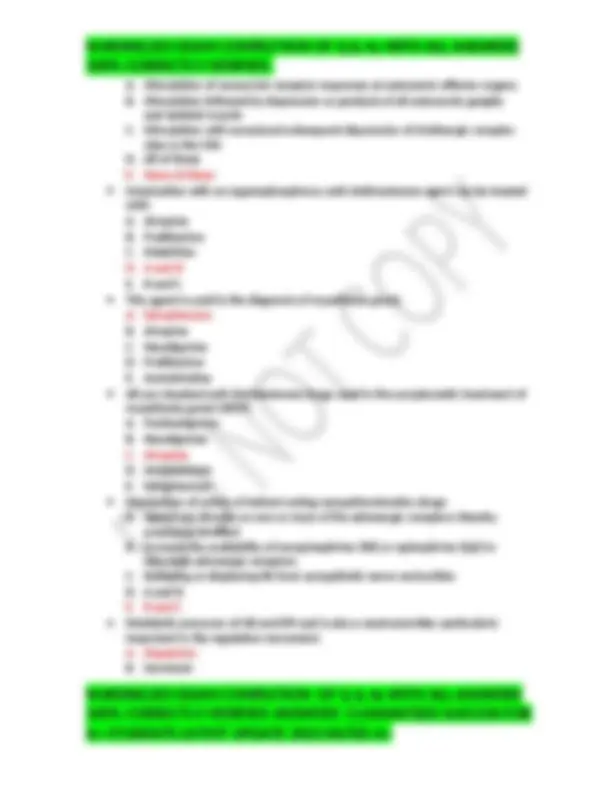
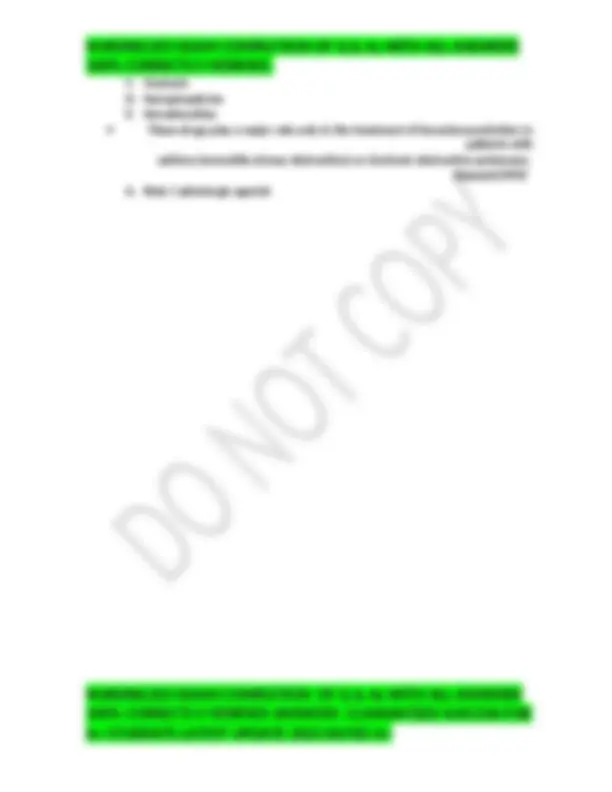
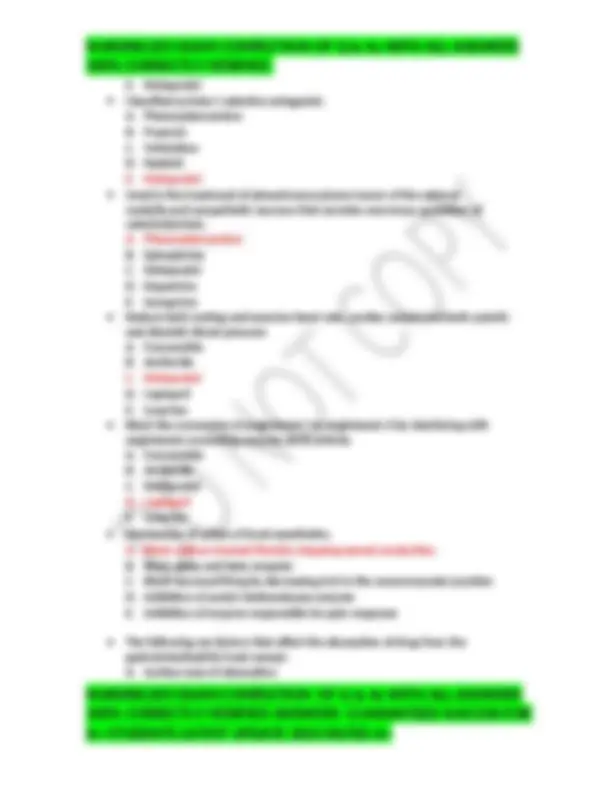
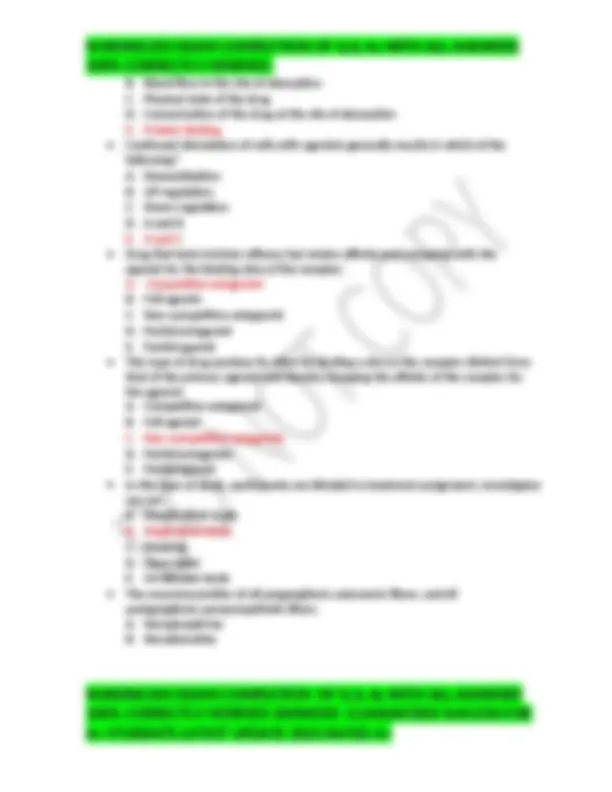
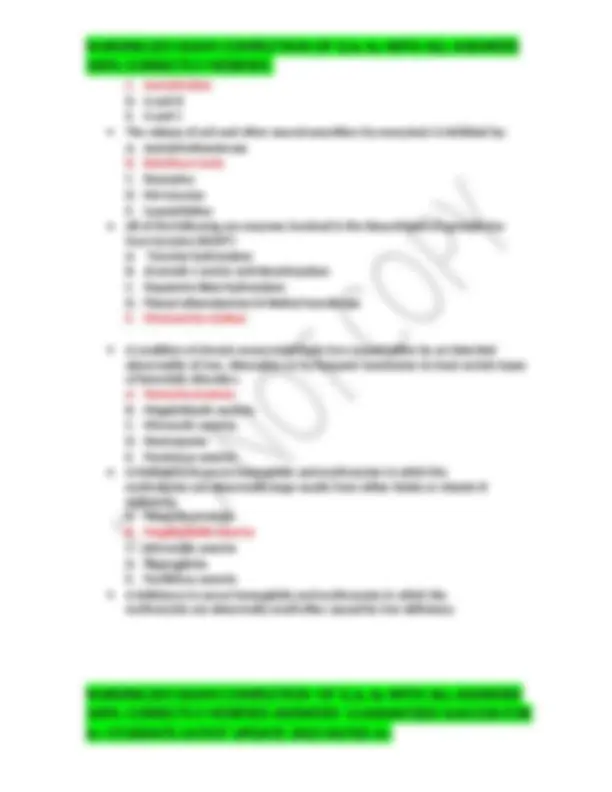
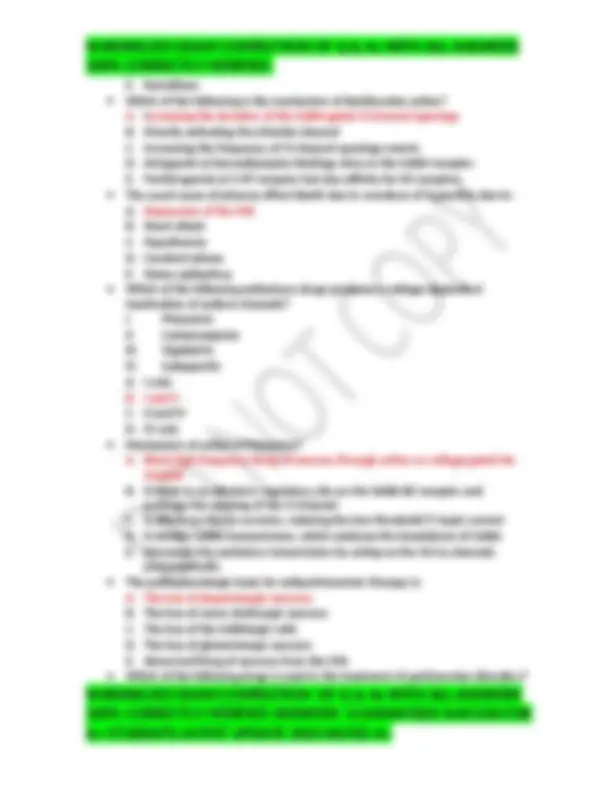
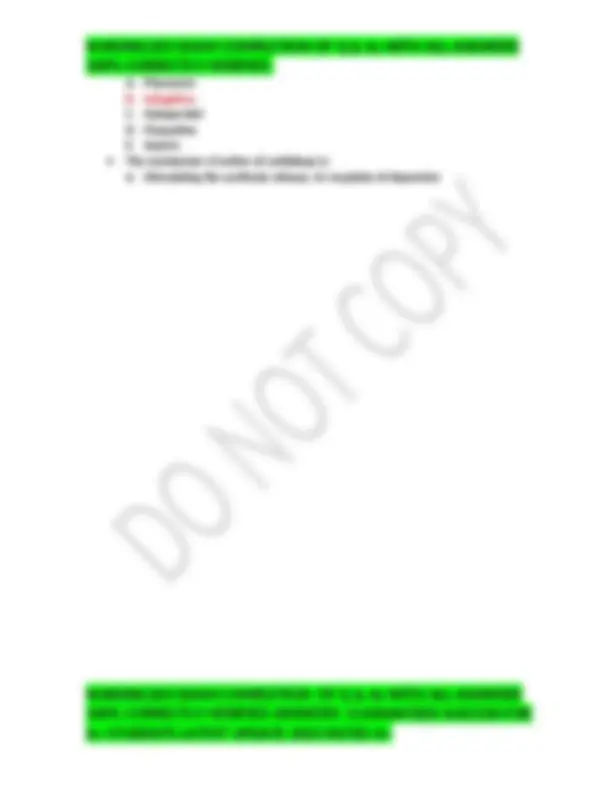
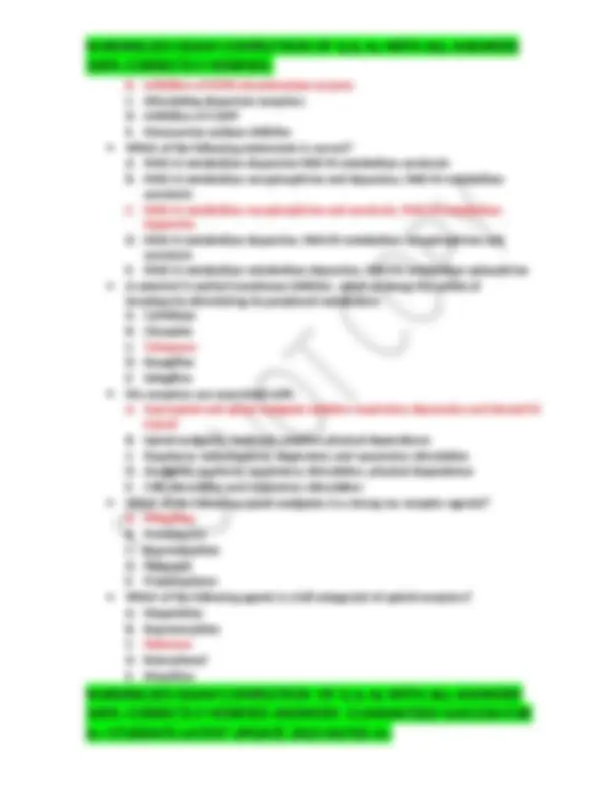
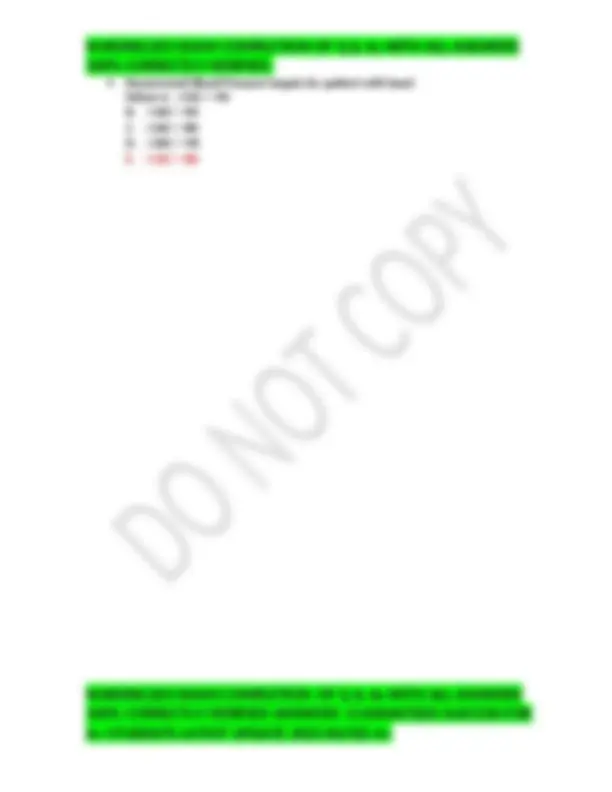
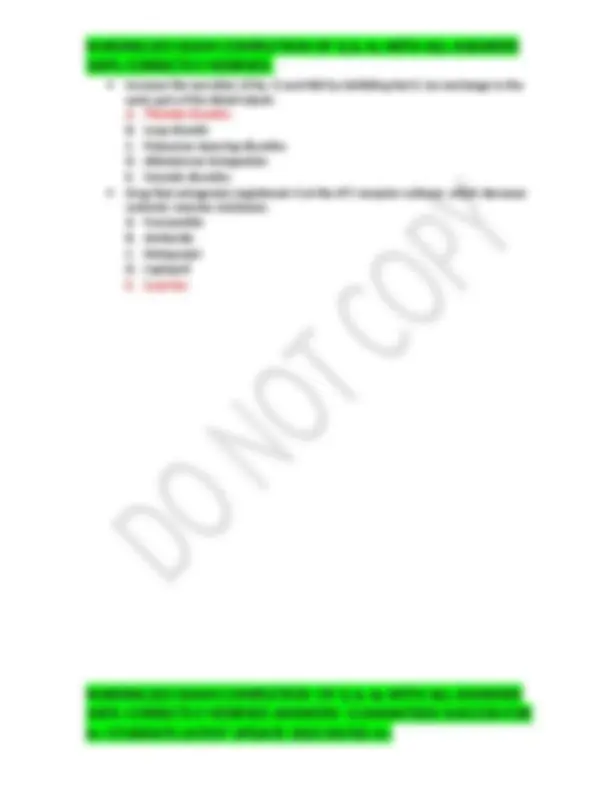


Study with the several resources on Docsity

Earn points by helping other students or get them with a premium plan


Prepare for your exams
Study with the several resources on Docsity

Earn points to download
Earn points by helping other students or get them with a premium plan
Community
Ask the community for help and clear up your study doubts
Discover the best universities in your country according to Docsity users
Free resources
Download our free guides on studying techniques, anxiety management strategies, and thesis advice from Docsity tutors
NURSING203 EXAM COMPLETION OF Q & As WITH ALL ANSWERS 100% CORRECTLY/VERIFIED.
Typology: Exams
1 / 19

This page cannot be seen from the preview
Don't miss anything!












Rate limiting enzyme in the synthesis of catecholamines A. Tyrosine hydroxylase B. Aromatic L-amino acid decarboxylase C. Dopamine beta-hydroxylase D. Phenyl ethanolamine-N-Methyl transferase E. COMT All of the following are effects of activating beta 2 receptor EXCEPT: A. Bronchoconstriction B. Uterine Relaxation C. Glycogenolysis D. Gluconeogenesis E. Bronchodilation All of the following are effects of activating alpha 1 receptor EXCEPT: A. Vascular smooth muscle relaxation B. Intestinal smooth muscle relaxation C. Increase contractive force of the heart D. Glycogenolysis in the liver E. Vascular smooth muscle constriction Which of the following is a pharmacological effect of muscarinic stimulation in the cardiovascular system? A. Vasoconstriction B. Decrease in cardiac rate C. Positive chronotropic effect D. Positive dromotropic effect E. Positive inotropic effect All of the following are naturally occurring chromonematic Alkaid EXCEPT: A. Pilocarpine B. Muscarine
C. Acetylcholine D. Arecoline E. None of these Which of the following is/are effects of cholinomimetic drugs? I. Stimulation of GI smooth muscle II. Stimulation of secretion of exocrine gland III. Bronchoconstriction IV. Tachycardia A. I and II B. II and III C. I, II and III D. I and IV E. I, II, III and IV Major contraindication to the use of muscarinic agonist are the following EXCETP: A. Asthma B. Hypothyroidism C. Coronary insufficiency D. Acid-peptic disease E. Hypertension Used in the treatment of glaucoma where it is instilled into the eye usually as a 0.5-4% solution. A. Epinephrine B. Eye-mo C. Pilocarpine D. Bethanecole E. Atropine Most effective prophylactic agent for short (4-6 hrs) exposure to severe motion also available as transdermal patch. A. Atropine B. Scopolamine C. Ipratropium D. Tiotropium E. Varenicline Which of the following drugs is/are classified an acetylcholinesterase inhibitor? I. Pilocarpine II. Edrophonium III. Tacrine IV. Atropine
A. Stimulation of muscarinic receptor responses at autonomic effector organs B. Stimulation followed by depression or paralysis of all autonomic ganglia and skeletal muscle C. Stimulation with occasional subsequent depression of cholinergic receptor sites in the CNS D. All of these E. None of these Intoxication with an organophosphorus anti-cholinesterase agent can be treated with: A. Atropine B. Pralidoxime C. Malathion D. A and B E. B and C This agent is used in the diagnosis of myasthenia gravis. A. Edrophonium B. Atropine C. Neostigmine D. Pralidoxime E. Acetylcholine All are standard anti-cholinesterase drugs used in the symptomatic treatment of myasthenia gravis EXCPT: A. Pyridostigmine B. Neostigmine C. Atropine D. Ambenonium E. Edrophonium Mechanism of action of indirect acting sympathomimetics drugs: A. Agents act directly on one or more of the adrenergic receptors thereby producing an effect B. Increase the availability of norepinephrine (NE) or epinephrine (Epi) to stimulate adrenergic receptors C. Releasing or displacing NE from sympathetic nerve varicosities D. A and B E. B and C Metabolic precursor of NE and EPI and is also a neutransmitter particularly important in the regulation movement. A. Dopamine B. Serotonin
C. Oxytocin D. Norepinephrine E. Noradrenaline These drugs play a major role only in the treatment of bronchoconstriction in patients with asthma (reversible airway obstruction) or chorionic obstructive pulmonary disease(COPD)’ A. Beta 1 adrenergic agonist
E. Phenobarbital Classified as alpha 2 selective antagonist. A. Phenoxybenzamine B. Prazosin C. Yohimbine D. Nadolol
E. Metoprolol Classified as beta 1 selective antagonist. A. Phenoxybenzamine B. Prazosin C. Yohimbine D. Nadolol E. Metoprolol Used in the treatment of pheochromocytoma tumor of the adrenal medulla and sympathetic neurons that secretes enormous quantities of catecholamines. A. Phenoxybenzamine B. Epinephrine C. Metoprolol D. Dopamine E. Isoxuprine Reduce both resting and exercise heart rate, cardiac output and both systolic and diastolic blood pressure A. Furosemide B. Amiloride C. Metoprolol D. Captopril E. Losartan Block the conversion of angiotensin I to angiotensin II by interfering with angiotensin converting enzyme (ACE) activity A. Furosemide B. Amiloride C. Metoprolol D. Captopril E. Losartan Mechanism of action of local anesthetics. A. Block sodium channel thereby stopping axonal conduction B. Block alpha and beta receptor C. Block neuronal firing by decreasing Ach in the neuromuscular junction D. Inhibition of acetyl cholinesterase enzyme E. Inhibition of enzyme responsible for pain response The following are factors that affect the absorption of drug from the gastrointestinal(GI) track except. A. Surface area of absorption
C. Acetylcholine D. A and B E. A and C The release of ach and other neurotransmitters by exocytosis is inhibited by: A. Acetylcholinesterase B. Botulinum toxin C. Reserpine D. Me tyrosine E. Guanethidine All of the following are enzymes involved in the biosynthesis of epinephrine from tyrosine EXCEPT: A. Tyrosine hydroxylase B. Aromatic L amino acid decarboxylase C. Dopamine Beta-hydroxylase D. Phenyl ethanolamine-N-Methyl transferase E. Monoamine oxidase A condition of chronic excess total body iron caused either by an inherited abnormality of iron, Absorption or by frequent transfusion to treat certain types of hemolytic disorders. A. Hemochromatosis B. Megaloblastic anemia C. Microcytic anemia D. Neutropenia E. Pernicious anemia A Deficiency in serum hemoglobin and erythrocytes in which the erythrocytes are abnormally large results from either folate or vitamin B deficiency A. Hemochromatosis B. Megaloblastic anemia C. Microcytic anemia D. Neutropenia E. Pernicious anemia A deficiency in serum hemoglobin and erythrocytes in which the erythrocytes are abnormally small often caused by iron deficiency
A. Hemochromatosis B. Megaloblastic anemia C. Microcytic anemia D. Neutropenia E. Pernicious anemia An abnormally low number of neutrophils in the blood patients with this condition are susceptible to serious infection A. Hemochromatosis B. Megaloblastic anemia C. Microcytic anemia D. Neutropenia E. Pernicious anemia A form of megaloblastic anemia resulting from deficiency of intrinsic factor, a protein produced by gastric mucosal cell and required for intestinal absorption of vitamin B A. Hemochromatosis B. Megaloblastic anemia C. Microcytic anemia D. Neutropenia E. Pernicious anemia Required for biosynthesis of heme and heme-containing proteins, including hemoglobin and myoglobin A. Deferoxamine B. Vitamin B C. Folic Acid D. Ferrous sulfate E. Filgrastim Stimulates G-CSF receptors expressed on mature neutrophils and their progenitors for the treatment of neutropenia A. Deferoxamine B. Vitamin B C. Folic acid D. Ferrous sulfate’ E. Filgrastim An endogenous anticlotting protein that irreversibly inactivates thrombin and factor Xa. Its enzymatic action is markedly accelerated by the heparins A. Antithrombin III B. Glycoprotein IIb/IIIa C. Clotting cascade
E. Ramelteon Which of the following is the mechanism of Barbiturates action? A. Increasing the duration of the GABA-gated Cl-channel openings B. Directly activating the chloride channel C. Increasing the frequency of Cl-channel openings events. D. Antagonist at benzodiazepine bindings sites on the GABA receptor E. Partial agonist at 5-HT receptor but also affinity for D2 receptor. The usual cause of adverse effect/death due to overdose of hypnoticis due to: A. Depression of the CNS B. Heart attack C. Hypothemia D. Cerebral edema E. Status epilepticus Which of the following antiseizure drugs produces a voltage-dependent inactivation of sodium channels? I. Phenytoin II. Carbamazepine III. Vigabatrin IV. Gabapentin A. I only B. I and II C. II and IV D. IV only Mechanism of action of Phenytoin? A. Block high-frequency firing of neurons through action on voltage-gated Na channel B. It binds to an allosteric regulatory site on the GABA-BZ receptor and prolongs the opening of the Cl-channel C. It effects on the Ca currents, reducing the low-threshold (T-type) current D. It inhibits GABA-transaminase, which catalyzes the breakdown of GABA E. Decreases the excitatory transmission by acting on the VG Ca channels presynaptically The pathophysiologic basis for antiparkinsonism therapy is: A. The loss of dopaminergic neurons B. The loss of some cholinergic neurons C. The loss of the GABAergic cells D. The loss of glutaminergic neurons E. Abnormal firing of neurons from the CNS Which of the following drugs is used in the treatment of parkinsonian disorders?
A. Phenytoin B. Selegeline C. Haloperidol D. Fluoxetine E. Aspirin The mechanism of action of carbidopa is: A. Stimulating the synthesis release, Or reuptake of dopamine
The diagnostic triad of opioid overdosage is: A. Mydriasis, coma and hyperventilation B. Coma, depressed respiration and miosis C. Mydriasis, chills and abdominal crampd D. Miosis, tremor and vomiting E. Mydriasis, diarrhea, increase urination Which of the following non-narcotic agents is salicylic acid derivative? A. Phenylbutazone B. Ketamine
C. Aspirin D. Tramadol E. Diclofenac Correct statements concerning aspirin include all of the following except: A. Irreversibly inhibits platelet COX B. Main adverse effects at antithrombotic doses are gastric upset (intolerance) and gastric and duodenal ulcers C. It inhibits platelet aggregation D. Safe to use in patients with hemophilia E. Epidemiologic studies suggest that long term use of aspirin at low dosage is associated with a lower incidence of colon cancer A drug that inhibit HMG-CoA reductase, it also reduces cholesterol synthesis and up regulate low density lipoprotein (LDL) receptors on hepatocytes A. Fenofibrates B. Colestipol C. Ezetimibe D. Aton statin E. Niacin A vasodilator that also inhibits plates function by inhibiting adenosine uptake and cGMP phosphodiesterase activity. A. Dypiridamine B. Abciximab C. Clostazol D. Anistreplase E. Streptokinase The mathematical product of peripheral vascular resistance(PVR) and cardiac output(CO). A. Hypertension B. Blood Pressure C. Hypotension D. Vascular pressure E. Afterload Recommendation on dietary approaches to stop hypertension (DASH). A. High intake of fruits B. Low fats dairy products along with reduced content of dietary cholesterol saturated fat and total fat C. The diet is rich on potassium and calcium and low in sodium D. High intake of vegetables E. All of these
Increase the excretion of Na, CI and H20 by inhibiting Na/Cr ion exchange in the early part of the distal tubule: A. Thiazide diuretics B. Loop diuretic C. Potassium Sparring diuretics D. Aldosterone Antagonists E. Osmotic diuretics Drug that antagonize angiotensin II at the AT1 receptor subtype, which decrease systemic vascular resistance. A. Furosemide B. Amiloride C. Metoprolol D. Captopril E. Losartan